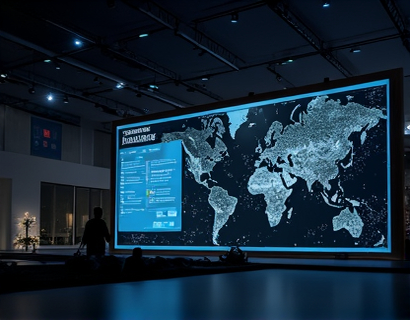Next-Gen QR Code Technology: Revolutionizing Business and Social Media Engagement for Modern Brands
In the rapidly evolving digital landscape, businesses and social media managers are constantly seeking innovative ways to enhance engagement and connect more effectively with their audience. One such technology that has emerged as a game-changer is the next-generation QR code, often referred to as enhanced or intelligent QR codes. These advanced QR codes go beyond the traditional static barcode, offering customizable and intuitive tools that streamline information sharing and boost customer interaction. This article delves into the transformative impact of next-gen QR code technology on business and social media engagement, highlighting its key features and benefits for modern brands.
Understanding Next-Gen QR Codes
Next-gen QR codes are an evolution of the traditional QR codes, designed to provide a richer and more interactive user experience. Unlike standard QR codes that primarily direct users to a URL or a simple piece of text, next-gen QR codes can store and display a variety of data types, including text, URLs, images, videos, and even interactive content such as augmented reality (AR) experiences. This versatility makes them an invaluable tool for brands looking to create engaging and memorable interactions with their audience.
The technology behind next-gen QR codes involves advanced encoding methods and larger data capacity, allowing for more complex and dynamic content to be embedded. This is achieved through the use of error correction codes and optimized data compression techniques, which ensure that the QR code remains scannable even when containing large amounts of data. The result is a more robust and flexible tool that can adapt to various marketing and engagement strategies.
Customization and Brand Integration
One of the most significant advantages of next-gen QR codes is their customization potential. Brands can tailor these codes to match their visual identity, incorporating their logos, color schemes, and branding elements. This level of personalization not only enhances the aesthetic appeal of the QR code but also reinforces brand recognition and consistency across different touchpoints. For instance, a retail brand can design a QR code that matches its packaging or store decor, creating a seamless and cohesive customer experience.
Moreover, the customization options extend to the content itself. Brands can create QR codes that lead to personalized landing pages, offering tailored messages or promotions based on user data or preferences. This targeted approach not only increases the relevance of the content but also improves user engagement and conversion rates. For example, a fashion brand can use a QR code on a product tag that, when scanned, directs the customer to a personalized style recommendation page based on their previous purchases or browsing history.
Enhanced User Experience
The user experience is a critical factor in the success of any digital engagement tool, and next-gen QR codes excel in this area. The intuitive design and quick scanning capabilities of these codes make them user-friendly, reducing the friction often associated with traditional QR codes. Users can easily access the embedded content without the need for additional apps or complex instructions, ensuring a smooth and seamless interaction.
Additionally, next-gen QR codes can provide real-time feedback and analytics, allowing brands to monitor user interactions and optimize their content accordingly. This data-driven approach enables brands to refine their strategies, identify trends, and make informed decisions to enhance user engagement. For instance, a travel company can track which destinations or promotions are most popular through QR codes and adjust their marketing efforts to focus on high-performing areas.
Interactive and Immersive Content
Next-gen QR codes open up new possibilities for creating interactive and immersive content, which is particularly valuable in the current digital landscape where user attention is scarce. By integrating AR technology, brands can offer augmented experiences that bring products or services to life. For example, a furniture retailer can use a QR code on a product display that, when scanned, overlays a 3D model of the furniture in the customer's home, allowing them to visualize how it would look in their space.
Similarly, in the realm of social media, next-gen QR codes can be used to create interactive stories or filters that engage users in unique ways. A music label can create a QR code that, when scanned, triggers an AR experience where fans can see their favorite artists in a virtual concert setting, complete with interactive elements and behind-the-scenes content. This not only enhances user engagement but also fosters a deeper connection between the brand and its audience.
Streamlined Information Sharing
Efficiency in information sharing is another key benefit of next-gen QR codes. Traditional QR codes often lead to long URLs or generic landing pages, which can be cumbersome and less effective in conveying the desired message. Next-gen QR codes can directly display concise and relevant information, such as a brief description, a call-to-action, or a summary of key points. This immediate access to information reduces the need for users to navigate away from the QR code, increasing the likelihood of engagement.
For educational institutions, for instance, a QR code on a brochure can directly link to a detailed course catalog or a video introduction to the institution, providing potential students with all the necessary information at a glance. This streamlined approach not only saves time but also enhances the overall user experience, making it more likely that users will take the desired action.
Enhanced Security and Trust
In an era where data privacy and security are paramount, next-gen QR codes offer enhanced security features that build trust with users. Advanced encryption methods can be employed to protect sensitive information, ensuring that user data is safe and secure. Additionally, the ability to track and verify the authenticity of QR codes helps prevent fraud and misinformation, further enhancing user confidence.
For financial institutions, this level of security is crucial. A bank can use a QR code to provide customers with secure access to their accounts or to initiate transactions, knowing that the process is protected by robust security measures. This not only protects the brand but also reassures customers that their information is handled with the utmost care.
Multi-Platform Compatibility
Next-gen QR codes are designed to be compatible with a wide range of devices and platforms, ensuring a consistent user experience across different environments. Whether scanned on a smartphone, tablet, or even smart displays, these codes adapt to the device's capabilities, providing an optimal viewing and interaction experience. This cross-platform compatibility is essential for brands that need to reach a diverse audience with varying devices and preferences.
For instance, a tech company can create a QR code that works seamlessly on both iOS and Android devices, ensuring that all potential customers can access the embedded content without any compatibility issues. This universal accessibility increases the reach and effectiveness of the QR code, making it a versatile tool for multi-channel marketing strategies.
Case Studies and Real-World Applications
To better understand the impact of next-gen QR codes, let's explore some real-world applications across different industries.
In the retail sector, a luxury fashion brand implemented next-gen QR codes on its product tags. When scanned, these codes not only directed customers to detailed product information and high-resolution images but also offered personalized styling advice based on the customer's previous purchases. This personalized touch not only enhanced the shopping experience but also led to a significant increase in sales and customer loyalty.
In the healthcare industry, a hospital used next-gen QR codes on patient wristbands to provide quick access to medical records, treatment plans, and emergency contact information. This streamlined process improved patient care and safety, as medical staff could rapidly retrieve critical information during emergencies.
In the travel industry, an airline company integrated next-gen QR codes into its boarding passes, which, when scanned, provided passengers with real-time flight updates, gate information, and even virtual tours of the airport. This not only reduced passenger anxiety but also enhanced the overall travel experience, leading to higher customer satisfaction ratings.
Challenges and Considerations
While next-gen QR codes offer numerous benefits, there are also challenges and considerations that brands should be aware of. One key challenge is ensuring that the embedded content remains up-to-date and relevant. Brands need to regularly monitor and update the content linked to their QR codes to avoid outdated or broken links, which can negatively impact user experience and brand reputation.
Another consideration is the need for clear instructions and guidance for users. While next-gen QR codes are designed to be user-friendly, some users may still require assistance in scanning and accessing the content. Providing simple, step-by-step instructions can help overcome this barrier and ensure a smooth interaction.
Additionally, brands should be mindful of the data privacy implications of using QR codes, especially when collecting user information. Transparent privacy policies and compliance with data protection regulations are essential to maintain user trust and avoid legal issues.
Conclusion
Next-gen QR code technology represents a significant advancement in digital engagement tools, offering brands powerful and versatile solutions to enhance their presence and interaction with their audience. By providing customizable, secure, and interactive content, these codes help brands create memorable and meaningful experiences that drive engagement and loyalty. As the digital landscape continues to evolve, embracing next-gen QR codes can be a strategic move for businesses and social media managers looking to stay ahead of the curve and connect more effectively with their audience.










































